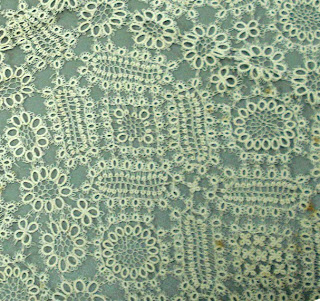
Old Style Tatting is the expression I use for that early work from before the invention of the join. (Does it have any other proper name?) Motifs were joined by tying the picots together. The motifs themselves were made up of strips of tatting sewn together. Elgiva Nicholls describes the process in her book, Tatting Techniques. Butterick's Tatting and Netting of 1896 has instructions for this type of work (though not too detailed), with patterns based on studying examples of tatting that were already old at the time.
Make a strip of rings, leaving a long tail of thread at the beginning. Have a bare thread double the length of the picots between rings.
Then use that beginning tail of thread to sew the rings together. The last picot of one ring and the first picot of the next one are caught together in a little knot. Then the thread ties into the base of the next ring, sometimes fastening it to a picot of a ring of an inner round. Needle lace stitches often fill in the centers. Then many motifs are basted down onto paper to hold them in place while knots are tied to join them together.

This one little motif took me a long, long time to make. I'm sure those tatters of old, who were accustomed to this sort of work could do it much faster. Still, with the effort involved, I'm amazed tatting as an art survived until the join was invented to make it easier.




12 comments:
Well, I am excited to learn from your findings! I can't imagine having to tie and sew together picots. It makes my head hurt to think about it :o)
That does look like a lot of extra work, but so pretty!
What a wonderful and fascinating idea for your blog! I can't imagine tying everything together lkr this. I think I'd have gone back to knitting or crochet. But like you sy the results are pretty wonderful. I can't believe you tried it too- how long did it take?
Do you really think NO ONE joined their picots?
Seems difficult to believe that some woman did not have the idea and to join those loops, and the tatting has not survived the ages. Or am I just saying that in hindsight? Honestly, I think some wily tatters must have joined the picots. An unsung tatter's tale... : )) Fox
Fascinating! They used such creativity within the limitations at the time. Thanks for doing these!
Its a beautiful piece of tatting, I posted a really old piece last year on my blog which I think was done by my grand mother long before I was born and my mother I worked out it must be nearly 100 year old. As I never found any shuttles when we strip out her home but we did find some old needles which look like tatting needles, so I wondering if she did it with a needle instead of a shuttle.
Margaret
Lovely indeed - but tedious! I can't imagine doing serious tatting (or even "just for fun" tatting) with a sewing or netting needle, one thread, and having to sew together the elements to create a single motif!
Good luck on the new blog - I'll be following it with interest!!
Wow! What a lot of work to make something so small. And that larger piece is almost unbelievable in what it took to make. And most of us now get impatient with large pieces and find all kinds of ways to not have to cut, tie and hide ends. Man, do we have it easy now!
It seriously surprises me that the old tatters stuck with it. As it is, tatting is a lot of work. The way you're describing it makes me wonder how it ever survived, nevermind becoming somewhat popular.
It's so delicate looking compared to modern tatting. I don't think I could have managed tatting that way, not necessarily because of the time involved, but because it would be hard for me to visualize the finished motif based on a strip of rings like that.
I think this is going to be a fascinating blog!
This will be a fascinating blog, and a big undertaking! I applaud your dedication to this subject.
It's great to see these examples. It's one thing to read that they tied the picots together, but another to actually see closeup photos! So tedious! I'm also impressed with that sample you tatted!
Even though I was an experienced knitter and crocheter and worked with thread, it astounded me when I found out that the way to connect the picots was to pull up a long loop and pass the shuttle through it! So simple! However, I don't know if I ever would have figured it out on my own! So I can't be too critical of the early tatters!
I'm also amazed that some tatters have a legacy of tatting in their family - going back several generations!
Lovely Blog. I have a Collar made in the same style.
With the centre filled in the pattern could easily have been for a table cloth.
The thread used is much finer than anything I would want to use.
Post a Comment